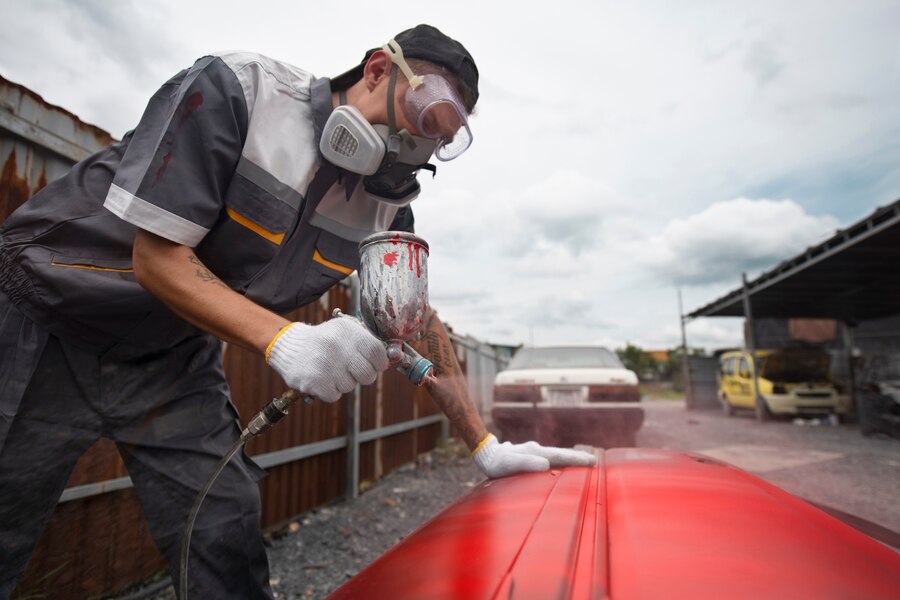Addressing roof leaks promptly during severe weather conditions is crucial for preventing further damage to your home. Extreme weather can exacerbate existing issues, leading to more significant problems if not managed quickly. Roof leaks during storms, heavy rain, or high winds can lead to extensive water damage, mould growth, and structural issues if left unattended.
Safety Considerations Precautions to Take When Repairing Roof Leaks
When addressing roof leak repair during extreme weather, safety must be a top priority. Ensure that you are using the appropriate safety gear, such as harnesses, helmets, and non-slip footwear. Additionally, consider the stability of ladders and scaffolding, as slippery or unstable surfaces can increase the risk of falls and accidents. If possible, avoid working on the roof during severe weather to prevent injuries.
Importance of Using Appropriate Safety Gear and Tools
Using the right safety gear and tools is essential to protect yourself while performing roof repairs. Safety gear should include harnesses, safety ropes, and helmets, while tools should be suited for the specific repairs you are undertaking. Make sure all tools are in good condition and that you have adequate lighting if working in poor visibility conditions.
When to Avoid DIY Repairs
Certain situations during extreme weather may be too risky for DIY repairs. If the weather is particularly severe, such as during a major storm or hurricane, it may be safer to wait for the conditions to improve before attempting repairs. Additionally, if the damage is extensive or the repair involves complex tasks, it is advisable to seek professional help. Attempting repairs in unsafe conditions can lead to personal injury and further damage to your roof.
Temporary Measures Effective Temporary Solutions for Dealing with Roof Leaks
While waiting for professional help, temporary measures can help mitigate damage from roof leaks.
- Using Tarps and Plastic Sheeting: Covering the leak with tarps or plastic sheeting can prevent additional water from entering your home. Secure the covering with heavy objects or tape to ensure it stays in place during strong winds.
- Applying Roofing Sealants and Patches: Roofing sealants and patches can provide a short-term fix by sealing small leaks and preventing water from penetrating further. These products are designed for quick application and can provide temporary relief until permanent repairs are made.
How to Secure the Work Area
Ensuring that the work area is secure is crucial for safety during roof repairs.
- Securing Ladders and Equipment: Make sure ladders and scaffolding are stable and placed on secure, level surfaces. Check that all equipment is properly secured and avoid overloading ladders with heavy materials.
- Protecting the Surrounding Area: Use barriers or caution tape to keep others away from the work area, reducing the risk of accidents and ensuring that the repair process is not interrupted.
Professional Help When and Why to Call in Professionals for Emergency Roof Leak Repairs
In many cases, especially during extreme weather, it is advisable to call in professionals for emergency roof leak repairs.
- Scenarios Where Professional Roofing Services Are Essential: If the damage is extensive, if you are unable to safely access the roof, or if the weather conditions are particularly severe, professional roofing services are essential. Professionals have the experience, equipment, and safety measures needed to handle complex repairs safely and effectively.
- Benefits of Hiring Experts for Urgent Repairs During Extreme Weather: Professional roofers are equipped to manage repairs under challenging conditions and can provide a permanent solution rather than a temporary fix. They also have access to high-quality materials and tools that can withstand extreme weather.
Finding Reliable Roofing Services
When searching for a roofing company to handle emergency repairs, consider the following tips:
- Check Credentials: Ensure that the roofing service is licensed, insured, and has a good track record of handling emergency repairs.
- Read Reviews: Look for customer reviews and testimonials to gauge the company’s reputation and reliability.
- Get Multiple Quotes: Obtain quotes from several roofing services to compare costs and services. This helps ensure you get a fair price and choose a reputable company.
Post-Storm Inspection Importance of Inspecting Your Roof After Severe Weather Events
After a severe weather event, it is crucial to inspect your roof to assess any damage and prevent further issues. Immediate post-storm inspections help identify problems early, which can prevent extensive damage and costly repairs. Inspecting your roof promptly also allows for timely intervention, reducing the risk of leaks, mould, and structural damage.
Steps to Take for a Thorough Post-Storm Roof Inspection
- Safety First: Ensure that you are safe before inspecting your roof. Use a sturdy ladder and wear appropriate safety gear. If the roof is too damaged or unsafe, consider hiring a professional for the inspection.
- Visual Inspection: Begin with a visual inspection of the roof from the ground. Look for obvious signs of damage such as missing or damaged shingles, broken gutters, and loose flashing.
- Check for Leaks: Examine the interior of your home for any signs of leaks, such as water stains on ceilings or walls. Leaks can indicate roof damage that may not be visible from the exterior.
- Inspect Flashing and Seals: Check the flashing around chimneys, vents, and skylights for any damage. Ensure that all seals are intact and that no water is seeping through these areas.
- Examine Gutters and Downspouts: Ensure that gutters and downspouts are clear of debris and are functioning properly. Damaged gutters can lead to water pooling on the roof, increasing the risk of leaks.
Common Damage Signs to Look for After a Storm
- Missing or Damaged Shingles: Shingles that are missing, cracked, or curled can lead to leaks and should be repaired or replaced.
- Broken or Dislodged Flashing: Flashing that is bent or detached from its proper position can allow water to enter the roof.
- Gutter Damage: Dents, holes, or separations in gutters can affect their performance and lead to water damage.
- Granule Loss: Asphalt shingles may lose granules during severe weather, which can reduce their effectiveness and lead to leaks.
How Roof Restoration Roofing Can Help Role of Roof Restoration Roofing in Addressing Storm-Related Damage
Roof restoration roofing services play a vital role in addressing storm-related damage by providing comprehensive repairs and enhancements. Restoration can include:
- Repairing and Replacing Damaged Areas: Professional roofers can repair or replace damaged shingles, flashing, and other roof components to restore the roof’s integrity.
- Applying Protective Coatings: Roof restoration often involves applying protective coatings that enhance the roof’s durability and resistance to future weather events.
- Addressing Structural Issues: Restoration services can also address underlying structural issues that may have been exacerbated by the storm, ensuring long-term protection for your home.
Long-Term Solutions Addressing Roof Damage for Long-Term Protection
To ensure long-term protection for your roof, it is essential to address any damage comprehensively and implement ongoing maintenance strategies:
- Comprehensive Repairs: Address all identified damage through comprehensive repairs to prevent future issues. This may include replacing damaged shingles, fixing leaks, and reinforcing weak areas.
- Regular Maintenance: Establish a regular maintenance schedule to inspect and clean your roof, ensuring that minor issues are addressed before they become major problems.
- Upgrading Materials: Consider upgrading to more durable roofing materials that can better withstand extreme weather conditions and reduce the likelihood of future damage.
The Role of Comprehensive Roof Restoration Roofing Services Comprehensive Roof Restoration Roofing Services
Roof restoration roofing services offer an in-depth approach to repairing and enhancing your roof, including:
- Detailed Inspections: Comprehensive inspections to identify all potential issues and assess the overall condition of the roof.
- Full Repairs and Replacements: Repairing or replacing damaged areas and components to restore the roof’s functionality and appearance.
- Preventative Measures: Implementing preventative measures such as installing improved flashing, ventilation, and protective coatings to enhance the roof’s resilience.
Planning and Implementing Long-Term Repair and Maintenance Strategies
- Develop a Maintenance Plan: Create a detailed maintenance plan that includes regular inspections, cleaning, and repairs. Schedule these activities to ensure that your roof remains in good condition.
- Budget for Repairs: Allocate a budget for ongoing roof maintenance and unexpected repairs to ensure that funds are available when needed.
- Work with Professionals: Partner with experienced roofing professionals to ensure that all repairs and maintenance are performed to a high standard.
Conclusion Summary of Key Points
- Handling Roof Leaks During Extreme Weather: Address roof leaks promptly and safely, using temporary measures if necessary and seeking professional help when needed.
- Post-Storm Inspection: Conduct a thorough inspection after severe weather to identify and address damage, and consider roof restoration roofing services for comprehensive repairs.
- Long-Term Solutions: Implement a maintenance plan and consider roof restoration roofing services to ensure long-term protection and performance of your roof.
Next Steps for Ongoing Roof Maintenance
- Regular Inspections: Schedule regular roof inspections to catch potential issues early and maintain the roof’s condition.
- Ongoing Maintenance: Continue with routine maintenance tasks, such as cleaning gutters and checking for damage, to prevent future problems.
- Professional Help: Engage with professional roofing services to handle complex repairs and ensure that your roof remains in optimal condition.
Extreme weather conditions can make roof repairs more challenging due to safety concerns and the increased risk of further damage. Heavy rain, strong winds, and ice can make it difficult to access the roof, and repairing leaks under such conditions requires careful planning and execution. Additionally, the intensity of the weather can exacerbate existing problems, making temporary fixes less effective.







